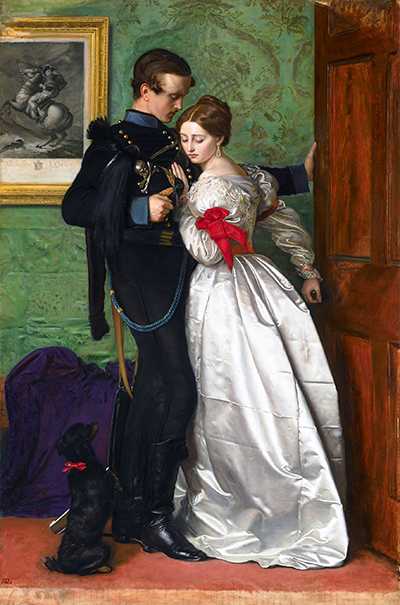The Black Brunswicker by John Everett Millais was inspired partly by the Black Brunswickers exploits, a German volunteer military unit of the Napoleonic Wars (1803–1815), during the Waterloo campaign, plus partially by the contrasts of pearl-white satin and black broadcloth in a time of tender conflict.
The painting took an estimated 3 months to paint. The artist paid close attention to the accuracy of the Brunswicker's uniform. The artist used Charles Dickens' daughter, Kate Perugini, as a model for the lady in the painting. The male model was an unknown soldier who passed away shortly afterwards. The models posed with wooden props.
It was purchased for 100 guineas, which is the highest price the artist has ever received from Ernest Gambart, a dealer and publisher. He sold it to Thomas Point, a famous Pre-Raphaelite collector. Later, William Hesketh Lever bought the painting for his private collection in 1898. In 1864, T.L. Atkinson engraved the work in mezzotint. Also, Millais painted 2 watercolour copies of this composition. The artwork was first exhibited at the London-based Royal Academy of Arts in 1860, and it's currently in the Liverpool-based museum called the Lady Lever Art Gallery.
The artwork depicts a Black Brunswicker about to leave for battle. His lover, who is wearing a ballgown, is restraining him and trying to close the door, while he's pulling it open. This indicates that this scene is inspired by the 15 June 1815 Duchess of Richmond's ball, from which the officers went to join other troops at the 16 June 1815 Battle of Quatre Bras. Millais wrote a letter to Effie Gray, his wife, describing his inspiration for the artwork and referred to a conversation with The Times war correspondent William Howard Russell. He said that he was intending the work to be a perfect match to The Huguenot, which is the first major success by Millais portraying a similar scene and features 2 lovers looking at each other longingly.
The artist originally intended the two pictures to be even more alike than they are now by repeating the theme of the armband that was used in the previous painting. Millais wanted the officer to wear a nice black crepe mourning armband and wanted the lover of the young officer to sew it around his arm, which was dropped as it doesn't appear in any existing preparatory drawings.




